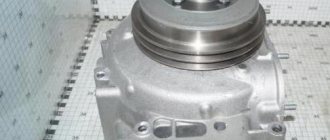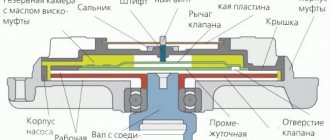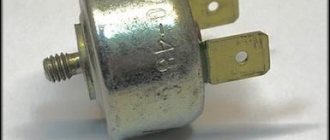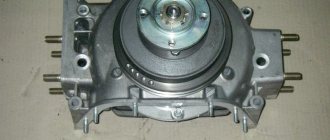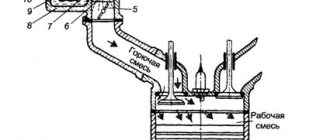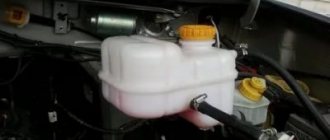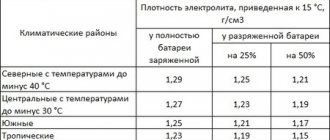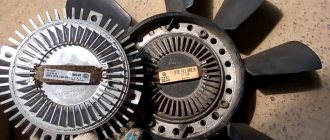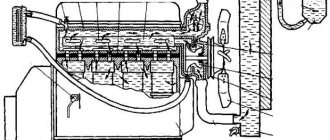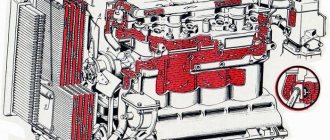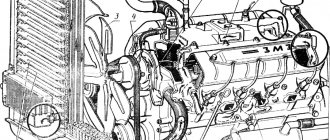The bearing on the Kamaz electric coupling is jammed. Repair.
Kamaz bearing replacement on an electric clutch
Kamaz hydraulic coupling part 2
And again the topic of stopping the fan on Kamaz
Animation of KAMAZ fluid coupling
Viscous coupling (viscous coupling) d=660mm, KAMAZ Euro-2 Euro-3, analogue of Borg Warner 18223-3
Did the electric cooling coupling break down on the road? Solvable!
Kamaz hydraulic coupling addition 2
Engine 740.31 EURO-2, produced by Naberezhnye Chelny Engine Plant
Purpose of the fluid coupling
The most important component for ensuring effective engine cooling is the fluid coupling. Without it, KamAZ would have a continuously running cooling fan. Its meaning is to turn on the fan at the right time and then turn it off. After all, when the engine warms up, as well as during cold operation of the car, airflow is not needed at all.
The direct purpose of the fluid coupling is to transmit the torque of the engine crankshaft to the cooling fan at the right time. It also significantly dampens sudden changes in the operation of the crankshaft and serves as a good damper for fan drive.
How this unique cooling system unit works will be clear from its structure.
Conclusion
The viscous coupling of an engine cooling fan is a simple and very reliable device that rarely fails. You can diagnose its breakdown without contacting specialists at a service station. One has only to monitor the engine temperature and check the operation of the fan, and everything will become clear. Although viscous coupling repair is not recommended by many experts, even a beginner can handle it. The choice of new devices is quite large: there are products from manufacturing companies from Europe, America and individual Asian countries (the best options), and there are auto parts from packaging companies, the best of which are German, American and French.
KamAZ hydraulic coupling device
Only if there is oil inside the working space will the hydraulic coupling work. KamAZ has the best designs for this. The operation of the clutch is based on two wheels: driving (9) and driven (10). The drive wheel has 33 blades and is connected to the engine crankshaft through the splined part of the shaft (7). The driven wheel has 32 blades and is inextricably linked to the driven shaft (16), which in turn drives the cooling fan. The drive shaft (7) rotates in bearings 8 and 19, and the driven shaft, in turn, in bearings 4 and 13.
The clutch impellers do not contact each other without oil. That is, when turned off, only the drive wheel rotates. The slave can spin passively, thanks to the rotation of the fan when the cooling radiator shutters are open. The fan fluid coupling has a reliable collapsible housing, consisting of a cover (1) and a casing (2). KamAZ has a well-thought-out leakage protection system. To prevent oil leakage, the fluid coupling has two oil seals (17, 20) and a gasket (18).
To ensure that oil enters the fluid coupling at the right time, there is a fluid coupling switch with a “flag” in three positions. Let's look at this simple, but at the same time integral component in more detail.
Kamaz electric coupling sensor
A truck engine produces a lot of heat. To prevent the mechanisms from overheating, it is necessary to use a cooling system. The most important cooling agent is antifreeze, which is “driven” by a special system throughout the entire mechanism that needs cooling. The second option is the natural intake of cool air. Fan operation is considered the most efficient.
Kamaz vehicles have two types of cooling: air and combined. The combined type is also called liquid-air. Both cooling options require a fan. This component of the entire cooling system experiences strong vibrations, heavy loads, and is subject to a serious noise effect. The fan speed may also gradually decrease. To ensure that the mechanism remains in the same mode, a special clutch is installed for the fan. It relieves large dynamic loads, taking part of the “impact” upon itself; accordingly, the presence of a coupling is necessary.
Fluid coupling switch
A metal case with a temperature sensor directly connected to the coolant is the fluid coupling switch. KamAZ has the following temperature regime: when the temperature of antifreeze or antifreeze rises to 83-86 ° C (hot or cold switch), the working mass in the sensor begins to melt and expand, pushing the rod. The channel for oil to enter the fluid coupling opens. When the coolant temperature drops back, the spring returns the switch opening rod to its place.
What do the three positions of the fluid coupling switch do? The “flag” of the switch allows you to select three main operating modes:
- auto;
- permanently open option;
- permanently closed.
It is clear that the automatic mode is the main operating mode and, if the fan fluid coupling is working properly, it does not switch to other positions. If a malfunction occurs in the switch (which is quite possible), it is set to the “permanently open” mode. And at the first opportunity the switch is replaced.
The third mode of the fluid coupling switch is “permanently closed”, used when the vehicle overcomes deep fords. In these cases, fan operation is not only unnecessary, but will only cause harm.
Posts 1 page 30 of 154
- Author: Chinese
- Guest
Actually the question is: How to properly check the thermal coupling? Car 65201. The car is constantly heating up. I wash the radiator and cooler every day, but it doesn’t help much. Thermostat OK! Should I leave the thermal coupling, or switch to an electric coupling with forced force? There are not enough forum participants, but suddenly someone had such a problem. Or a link where this is discussed. Thank you in advance.
- Author: Sergey
- Guest
- From: St. Petersburg
- Posts: 1161
- Gender: Male
- Spent on the forum: 1 month 13 days
When the propeller turns on, it makes such a noise that it’s simply impossible not to hear it. It doesn’t work for you.
- Author: Pan
- Moderator
- From: Kaluga
- Posts: 8044
- Gender: Male
- Spent on the forum: 3 months 19 days
I don’t know if I wrote in this thread or not, I didn’t want to start a new topic. Does anyone know, they are now producing motors with an electric fan coupling. I saw this on 43118. The control key in the cockpit is O.P.A. Convenient, compact and no extra troubles with oil. There is simply no such system available for sale. There are all sorts of newfangled fluid couplings, but there is none.
Operating principle of the fan fluid coupling
Now, after the internal structure of the fluid coupling has become clear, it is quite simple to understand how it all works. In automatic mode, the fluid coupling starts to move, and specifically, turns on the fan, when the coolant temperature rises to 83 oC or 86 oC. The fan, when turned on, blows on the radiator, thereby cooling the antifreeze and maintaining the optimal engine temperature.
When the antifreeze temperature drops, the fluid coupling switch is activated and it turns off the fan rotation. After this, it can only rotate passively, from the flow of incoming air due to the movement of the car (with the radiator shutters open).
It also now becomes clear how to ensure uninterrupted operation of the cooling fan. The easiest way is to set the “flag” of the fluid coupling switch to the “permanently open” position. The fan will constantly spin, since the oil will be in the fluid coupling all the time, and it will work in continuous mode as long as the engine crankshaft is spinning.
How to remove a viscous coupling on a Kamaz
The viscous coupling of a KAMAZ vehicle requires servicing after the vehicle has been idle for a long time.
Wear of spare parts and prolonged neglect of oil changes can cause breakdowns. It is difficult to diagnose a malfunction of a viscous coupling, so any work related to it is recommended to be carried out within the walls of a service station. Noises and fluid leaks indicate the need for service. Equipment does not always require replacement. In some cases it can be repaired. Usually the cause of breakdowns is silicone leakage. To eliminate the malfunction, it is enough to remove and disassemble the coupling, apply silicone to it, wait until it penetrates into the viscous coupling and install the spare part in place. Problems in the operation of a viscous coupling are often caused by bearings. In this case, extraneous noise appears in the location area of the radiator of the cooling system. To repair the device, it is necessary to dismantle it, remove oil and other consumable fluids, and replace the bearing with a new one. Incorrect clutch behavior is not always a signal to purchase a new unit. The craftsmen explain that the KAMAZ viscous coupling bearing is rarely found in stores, so it is better to entrust all work to professional technical stations, where they will have everything necessary for repair and replacement of parts.
The specificity of the viscous coupling service work lies in the need to organize a hole into which the consumable fluid will be poured. In this case, amateurs can ruin the spare part, while professionals quickly arrange the required hole and carry out the necessary procedures to restore the correct operation of the mechanism and the entire system.
It is worth considering that viscomfuta is made from elements that are not resistant to the use of brute force. Aluminum elements often bend in the hands of beginners who decide to carry out service themselves, and the part turns out to be unsuitable for subsequent use. Therefore, repair work carried out by specialists will be the most relevant solution.
Alfa-Auto technical service provides any services for diagnosing, repairing and replacing worn parts for any model of KAMAZ vehicles. We provide a guarantee for all work carried out and carry it out exactly within the agreed time frame.
- Changing the fan clutch with your own hands
- Operating principle of the fan clutch.
- Fan clutch device.
- Replacing the fan clutch.
When an internal combustion engine operates, a large amount of heat is generated, the engine heats up, and there is a need for cooling in order to avoid its failure.
In most cases, the coolant (in addition to the air flowing around the engine) is a special coolant. The liquid, circulating through the engine channels, picks up heat and transfers it to the radiator, in which it is cooled, partly by the incoming air flow, and mainly by the fan. There are mainly two types of cooling used on cars: air and combined (liquid-air). In both cases, a fan is used for cooling. To remove large dynamic loads from the fan, vibrations and noise effects, as well as to maintain the required rotation speed, depending on the coolant temperature, a clutch is used.
Operating principle of the fan clutch.
Fan couplings are divided into: elastic, friction, electromagnetic, hydraulic, viscous couplings.
An elastic coupling, through the rubber parts of two contacting disks, transmits torque from the drive disk to the driven disk, to which the fan is attached. When the engine abruptly switches from one mode to another, shock loads are absorbed due to the elasticity of the rubber that connects the driven and driven disks. The fan constantly rotates due to a V-belt transmission from the fan drive gear to its pulley.
The fluid coupling provides a smoother switching on and off of the fan; this happens automatically and depends on the increase in coolant temperature. The substance in the switch cylinder is heated to the melting point, its volume increases, the spool moves, opening the oil access channel to the fluid coupling. The more oil enters the clutch, the higher the fan speed. When the oil access channel to the clutch is closed, the fan turns off.
Electromagnetic coupling. When the coolant temperature reaches 90-95°C, the sensor supplies power to the electromagnet, which is triggered, and the metal ring, being magnetized to the pulley, turns on the fan. When the coolant temperature drops to 75-78°C, the fan turns off.
Viscous coupling is a type of fluid coupling. Its work is based on the use of the viscosity properties of the oil. When the engine is cold, the coolant circulates in a small circle, and the oil access channel to the clutch rotor is closed. Under the influence of centrifugal forces, the oil is pumped into the reserve cavities, and the fan speed drops. As the temperature rises, the coolant circulates in a large circle and enters the radiator; the air passing through it heats up and, in turn, heats the bimetallic plate; the plate, bending, opens one valve for oil access into the working cavity.
Oil getting onto the splines of the drive and driven wheels increases the fan speed, and the temperature rise slows down. With a further increase in temperature, the bimetallic spring opens the second oil access valve into the working cavity. Due to the viscosity of the oil, the fan picks up speed sufficient to maintain the set coolant temperature and, accordingly, prevents the engine from overheating. In most cases, silicone oil is used, which has a high viscosity and the ability to increase viscosity with increasing temperature.
Nowadays, electric fans with electronic control are increasingly being used. Signals from temperature sensors are transmitted to the control unit, analyzed, and a command is given to turn the fan on or off or adjust its speed.
Fan clutch device.
The elastic fan coupling is made of two steel disks (driver and driven), connected by rubber. The drive disk has seating teeth along the inner diameter, which fit onto the shaft. The driven disk has threaded bushings soldered to it for mounting the fan.
The fan friction clutch is designed in almost the same way as a clutch, that is, there is a friction (driven) disk, a drive disk, a pressure disk, a diaphragm spring, etc. The difference is the drive. The fan with a friction clutch is switched on and off using air pressure. The fan fluid coupling includes parts of the driving and driven parts. The drive parts include: splined drive shaft, drive wheel, housing, pulley shaft, pulley.
All parts are assembled on a splined drive shaft and rotate on two ball bearings from the engine crankshaft.
The parts of the driven part include: driven shaft, driven wheel, fan mounting hub.
The driven part parts are assembled on the driven shaft and rotate on two ball bearings. Radial blades are cast on the inner surfaces of the drive and driven wheels facing each other, which serve to transmit torque from the drive to the driven wheel. The rotation speed of the driven wheel depends on the amount of oil supplied from the lubrication system to the working cavity of the fluid coupling. To turn on the supply of oil from the oil system to the hydraulic coupling, a switch is used, consisting of: a housing, a spool with a return spring, a tap, a thermal power sensor, and a washer for adjusting the response temperature.
Features and weaknesses of the fluid coupling
The fluid coupling is a rather complex unit, and it may seem that it is not a very reliable design. But in practice, the fluid coupling itself practically does not break. Its reliability is exceptionally high. The weak point in the system for transmitting torque from the crankshaft is the inclusion of the fluid coupling. KamAZ has a rather weak fluid coupling switch. It is the element that can fail the entire cooling system of the car.
The seals and bearings in the fluid coupling itself can theoretically wear out. But these components are selected based on typical loads, plus a certain margin of safety. For them to fail there must be an unplanned impact. In cases where the vehicle operates smoothly and with regular maintenance, the fluid coupling can operate without repair or replacement.
KAMAZ electric coupling activation sensor
Today, automotive technology is widely used in all sectors of modern society. Based on the tasks performed by this equipment, appropriate requirements are imposed on its components and assemblies.
The main unit of any type of automotive technology is the engine. Accordingly, the performance of the engine determines the performance of the machine as a whole. The failure of engine parts is one way or another accompanied by a violation of the normal temperature regime of its operation, which in turn is provided by the engine cooling system.
The most common in modern engines is a closed liquid cooling system, the design of which includes a liquid pump, a cooling jacket, thermostats, a radiator, an expansion tank, a driven fan, blinds (or curtains), a radiator diffuser, connecting pipes and hoses, as well as control measuring instruments.
The fan is an integral part of the cooling system of any modern car engine. It serves to increase the cooling intensity of the liquid in the radiator. The fan can have various drives. The mechanical drive transmits rotation to the fan from the crankshaft through a gear or V-belt drive, as well as through elastic and inelastic couplings. The advantage of this drive is its simplicity. However, a significant disadvantage of this drive is the lack of the ability to briefly turn off the fan to ensure less heat removal from the radiator and, as a consequence, engine overcooling. The solution to this problem is the use of drives whose design provides the ability to turn off and turn on the fan, if necessary, in both automatic and forced modes. These include viscous, hydrodynamic, and electromagnetic couplings. The main disadvantage of viscous and hydrodynamic couplings is the complexity of their design, which results in high cost.
The design of electromagnetic couplings is simpler, which makes them cheaper. It is also possible to use this coupling in conjunction with a mechanical drive. For example, on engines of the KamAZ family, an electromagnetic clutch is installed, shown in Fig. 1. The operation of this clutch is controlled using a thermobimetallic sensor, which, when the temperature of the coolant rises above the operating temperature, closes the electrical circuit, and an electric current is supplied to an electric coil with a metal core, fixedly fixed inside the rotating pulley, resulting in a magnetic field. Under the influence of magnetic forces, the driven disk mounted on the fan hub is attracted to the pulley, as a result of which the fan begins to rotate along with the pulley. The disadvantage of this drive is that if there is no electric current in the circuit, torque will not be transmitted to the fan. This can lead to engine overheating and failure.
Based on this, it is advisable to change the design of this drive in such a way that torque is transmitted to the fan even in the event of an electrical circuit failure.
As a solution to this problem, we propose the design of an electromagnetic coupling, shown in Fig. 2.
The proposed electromagnetic fan drive clutch consists of a pulley, a fixed electromagnetic coil, a bearing, a fan hub, pads with friction linings and spacer springs. Its work is carried out as follows. The pulley receives constant rotation from the engine crankshaft. Through the projections, the pulley engages with friction linings, which, under the action of spacer springs, are pressed tightly against the fan hub. In this case, the fan is set in motion. When rotating, the pads are also subject to centrifugal forces, which increase the pressure of the pads and prevent the fan from slipping.
b
Rice. 1. Electromagnetic clutch of the fan drive: a – friction disc cutout; b – threaded hole of the pulley; 1 – adjusting bolt; 2 – bearing; 3 – fan hub; 4 – pulley mounting bolt; 5 – gasket; 6 – friction disc mounting bolt; 7 – friction disc; 8 – fan; 9 – drive pulley for the generator and liquid pump; 10 – electromagnetic coil; 11 – bolt for fastening the electromagnetic coil; 12 – power take-off shaft; 13 – front crankcase cover; 14 – fan switch sensor; 15 – spring plate
Rice. 2. Electromagnetic clutch of the fan drive: 1 – Fixed electromagnetic coil; 2 – pulley; 3 – bearing; 4 – fan hub; 5 – pads with friction linings; 6 – spacer springs; 7 – pulley protrusions
When the coolant temperature drops below the operating temperature, a thermobimetallic sensor installed in the coolant flow in the cooling jacket closes the electrical circuit. In this case, an electric current enters the electromagnetic coil, resulting in a magnetic field. Under the influence of a magnetic field, the pads overcome the resistance of the spacer springs and centrifugal forces and disengage with the fan hub, while the fan rotation stops and the radiator is not blown.
As the coolant temperature rises above the operating temperature, the thermobimetallic sensor opens the electrical circuit again. In this case, the magnetic field disappears, and the pads are pressed against the hub under the action of spacer springs and centrifugal forces. The fan starts up again.
Thus, with this design, it is possible to use an electromagnetic clutch as a fan drive. In this case, the possibility of stopping the rotation of the fan due to a malfunction of the electrical circuit is excluded. With all this, the proposed coupling retains the geometric dimensions of the original electromagnetic coupling, which will allow their interchangeability. An application for a utility model has been submitted to Rospatent for the proposed design.
Advantages of a fluid coupling
If we consider other types of couplings in the fan drive, namely electric and viscous couplings, the fluid coupling has clear advantages.
- There is no entire electrical circuit to control and monitor the operation of the unit.
- Higher design reliability, which increases uptime during engine operation.
- Turning the fan on and off with a fluid coupling is the fastest.
All the obvious advantages of the fluid coupling are noticeably worsened by the not most reliable element of the system - its switch. In practice, different methods are used to increase overall reliability. One of these is the use of a switch from Ural-4320.
How to identify a malfunction?
There are several factors to ensure long-term and trouble-free operation of the fluid coupling. KamAZ is very reliable, but there are some nuances. First of all, this is, of course, the working fluid coupling switch. In practice, most problems arise precisely because of its incorrect operation. This turns this part into a consumable item, along with engine filters.
The next factor will be the quality of the engine oil. If you have good all-season motor oil, the fluid coupling will operate normally and efficiently. KamAZ is not so demanding in everything, but not in this case. This must be taken into account when operating the car in winter.
It is also necessary to note the regular inspection of the engine cooling system for leaks. Any traces of coolant or oil must be removed promptly. The most insignificant leak without intervention can destroy the entire engine.
Deterioration in the performance of the fluid coupling can be easily determined by a decrease in the speed of the cooling fan. If it does not spin at all on a hot engine, the breakdown is obvious. It's good if the fan drive belt is simply worn out or loose. If it is a hydraulic coupling oil seal, KamAZ will require more labor-intensive work.
How to replace a fluid coupling?
The fluid coupling works for a long time without any intervention. KamAZ-740 can afford this. But sooner or later everything wears out. If this happens and the further efficiency of the cooling system is in question, it is necessary to dismantle the element.
The installation location of the fan drive and fluid coupling significantly complicates the replacement work. First of all, you need to gain access to the engine. In the case of a KamAZ vehicle, this is done by raising the cab. The sequence of work to replace the fluid coupling may look like this:
- drain engine oil;
- remove the attachment belt;
- unscrew the cooling fan;
- remove the oil pan;
- remove the cooling radiator;
- remove the oil cooler;
- remove the oil filter;
- provide access to the front cover of the block by lifting the engine;
- remove the front cover together with the fluid coupling.
After the fluid coupling is removed, the degree of wear and types of defects are revealed. If possible, some elements are replaced. But given the complexity of the operation to replace the coupling, it is recommended to replace the entire assembly. It’s even better and easier to replace the fluid coupling assembly with the front cover of the block.
After the reverse assembly procedure has been performed, it is necessary to check the tightness of the system and then only the functionality of the fluid coupling. When replacing a unit, you must choose an original part and not look for adventures in selecting any analogues.
Selecting a new device
Now let's answer the question of how to choose a viscous coupling for a cooling fan. The easiest way to search is in online stores, because here you can, if not buy a new device, then at least find out the code of the original and the codes of all possible analogues. We'll talk about the latter shortly. You can search by:
- VIN code;
- Vehicle data. We are talking about the make, model, year of manufacture and engine parameters. Typically, this search method is the main one in online auto parts stores.
Of course, an important search parameter is the manufacturer of the final product. Many car enthusiasts justifiably do not trust the products of packaging companies. In the case of viscous couplings, you can even take products from such companies, since, in fact, they are produced by a limited number of companies, which are also suppliers to the conveyors of large automobile concerns and whose products are even sold by packers . It is worth paying attention to the products of these companies:
- Behr-Hella (Germany);
- Nissens (Denmark);
- Mobis (South Korea);
- Beru (Germany).
Very good solutions can be found in the catalogs of Meyle and Febi (Germany). The Polish and Turkish analogs that appeared relatively recently did not perform so well. As a rule, reputable manufacturers of viscous couplings simultaneously produce radiators, fasteners and some pipeline elements. If you are confident in a certain radiator manufacturer, it is worth looking in its catalogs for the viscous coupling you need.
Prevention and Maintenance
The fluid coupling drive ensures correct and uninterrupted operation for quite a long time. KamAZ generally has a good margin of reliability. And in order for this to last as long as possible, there is no need for special maintenance. Prevention of malfunctions consists of general regular inspection, scheduled maintenance with high-quality replacement of oils and other technical fluids.
Also, when operating and servicing a fluid coupling, you should always pay attention to its weak points - the switch. Timely replacement of a faulty switch can greatly facilitate the operation of the unit as a whole.
